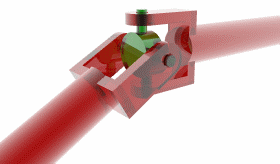From Wikipedia, the free encyclopedia

A universal joint
A universal joint, U joint, Cardan joint,
Hardy-Spicer joint, or
Hooke's joint is a joint in a rigid rod that allows
the rod to 'bend' in any direction, and is commonly used in shafts that transmit
rotary motion. It consists of a pair of hinges located close together,
oriented at 90° to each other, connected by a cross shaft.
[edit]
History
The main concept of the universal joint is based on the design of gimbals, which have
been in use since antiquity. One anticipation of the universal joint was its use
by the Ancient Greeks on ballistae. The first person
known to have suggested its use for transmitting motive power was Gerolamo Cardano, an
Italian mathematician, in 1545, although it is unclear whether he produced a
working model. Christopher Polhem
later reinvented it and it was called "Polhem knot". In Europe, the device is
often called the Cardan joint or Cardan shaft. Robert
Hooke produced a working universal joint in 1676, giving rise to an
alternative name, the Hooke's joint. Though the first use of the name
universal joint is sometimes attributed to American car manufacturer Henry
Ford, the term appeared in patent documents as early as 1884 when Charles H.
Amidon was awarded United States Letters Patent No. 298,542 for a bit brace.
[edit]
Equation of motion
Diagram
of variables for the universal joint. Axle 1 is perpendicular to the red plane
and axle 2 is perpendicular to the blue plane at all times. These planes are at
an angle β with respect to each other. The angular displacement (rotational
position) of each axle is given by
γ1 and
γ2 respectively, which are the angles of
the unit vectors
and
with respect to their initial positions along the x and y axes. The
and
vectors are fixed by the gimbal connecting the two axles and so are constrained
to remain perpendicular to each other at all times.
The Cardan joint suffers from one major problem: even when the drive shaft
axle rotates at a constant speed, the driven shaft axle rotates at a variable
speed, thus causing vibration and wear. The variation in the speed of the driven
shaft depends on the configuration of the joint, which is specified by three
variables:
- γ1 The angle of rotation for axle 1
- γ2 The angle of rotation for axle 2
- β The bend angle of the joint, or angle of the
axles with respect to each other, with zero being parallel or straight through.
These variables are illustrated in the diagram on the right. Also shown are a
set of fixed coordinate axes with unit vectors
and
and the planes of rotation of each axle. These planes of rotation are
perpendicular to the axes of rotation and do not move as the axles rotate. The
two axles are joined by a gimbal which is not shown. However, axle 1 attaches to
the gimbal at the red points on the red plane of rotation in the diagram, and
axle 2 attaches at the blue points on the blue plane. Coordinate systems fixed
with respect to the rotating axles are defined as having their x-axis unit
vectors (
and )
pointing from the origin towards one of the connection points. As shown in the
diagram,
is at angle γ1 with respect to its
beginning position along the x axis and
is at angle γ2 with respect to its
beginning position along the y axis.
is confined to the "red plane" in the diagram and is related to γ1 by:
-
is confined to the "blue plane" in the diagram and is the result of the unit
vector on the x axis
being rotated through Euler angles ]:
-
A constraint on the
and
vectors is that since they are fixed in the gimbal, they must remain at right
angles to each other:
-
Thus the equation of motion relating the two angular positions is given
by:
-
The angles γ1 and γ2 in a rotating joint will be functions of
time. Differentiating the equation of motion with respect to time and using the
equation of motion itself to eliminate a variable yields the relationship
between the angular velocities ω1 =
dγ1 / dt and ω2 = dγ2 /
dt:
|
|
| Angular (rotational) output shaft speed
versus rotation angle
for different bend angles
of the joint |
Output shaft rotation angle, ,
versus input shaft rotation angle, ,
for different bend angles, ,
of the joint |
-
As shown in the plots, the angular velocities are not linearly related, but
rather are periodic with a period twice that of the rotating shafts. The angular
velocity equation can again be differentiated to get the relation between the
angular accelerations a1 and a2:
-
[edit]
Double Cardan Shaft

Universal
joints in a driveshaft
A configuration known as a double Cardan joint drive shaft partially
overcomes the problem of jerky rotation. In this configuration, two U-joints are
utilised where the second U-joint is phased in relation to the first U-joint in
order to cancel the changing angular velocity, and an intermediate shaft
connects the two U-joints. In this configuration, the assembly will result in an
almost constant velocity, provided both the driving and the driven shaft are parallel and the two
universal joints are correctly aligned with each other - usually
90°. This assembly is commonly employed in rear wheel drive
vehicles, where it is known as a drive shaft or propeller
(prop) shaft.
Even when the driving and driven shafts are parallel, if
0°, oscillating moments are applied to the three shafts as they rotate. These
tend to bend them in a direction perpendicular to the common plane of the
shafts. This applies forces to the support bearings and can cause "launch
shudder" in rear wheel drive vehicles.[1]
The intermediate shaft will also maintain a sinusoidal angular velocity,
which contributes to vibration and stresses.